Buthrotum (Butrint) (2)
Buthrotum (Greek: Βουθρωτόν): port in western Epirus, modern Butrint.
The Hellenistic Age
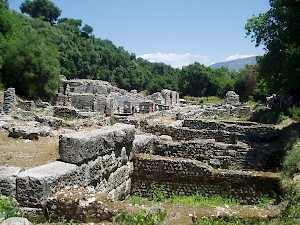
The new Molossian kingdom allied itself to Macedonia in c.360 BCE; to conclude the alliance, a princess of the royal house, Olympias, married to king Philip II of Macedonia. When their son Alexander the Great set out to conquer the east, his uncle and namesake Alexander, brother of Olympias and king of Molossis, set out to conquer Italy (331 BCE). He achieved some successes, but was killed in action. An interesting treasure of Italian coins found in Buthrotum suggests that one of Alexander's soldiers, having survived the disaster, managed to return home.
After the death of the king, the Molossian kingdom fell apart, and the Chaonians regained some independence, building Phoenice as their capital. Buthrotum was capital of the district of the Prasaebes, who must have lived on the Poseidium Peninsula and the eastern shore of Lake Palodes.
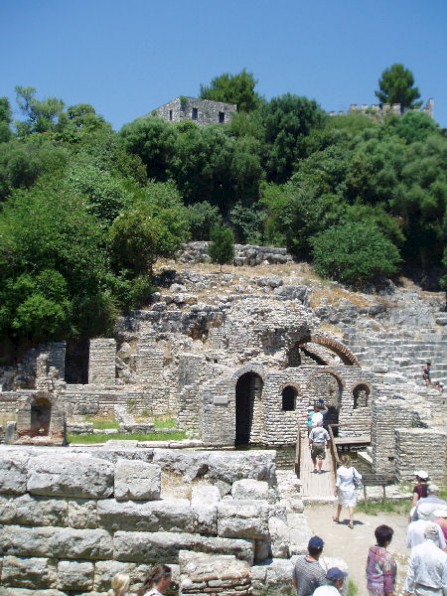
In these years, the temple of Asclepius was built, a small sanctuary dedicated to the healing god, who was increasingly popular in the Hellenistic Age. Next to it was a stoa of about thirty meters long, which must have been the place where the pilgrims slept. It shows how much the Chaonians tried to live like Greeks.
This, of course, did not prevent war. In 297, Pyrrhus reunited the Epirotes again, and three years later, the three tribes obtained Ambracia in the south, a Greek town that was to become the new capital of Epirus. Although it was not in the center of the kingdom, it had the advantage that it was neither Chaonian, nor Molossian, nor Thesprotian.
 Buthrotum, Theater, Façade |
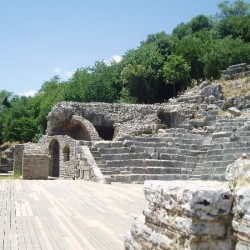 Buthrotum, Theater, Orchestra |
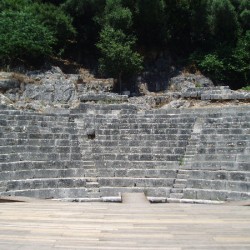 Buthrotum, Theater, Seats |
 Buthrotum, Theater, Stage |
As is well-known, Pyrrhus conducted many wars: in Aetolia, in Macedonia (where he briefly occupied the throne), in southern Italy against the Romans, and on Sicily against the Carthaginians, until he was defeated by the legions of Rome at Beneventum (275). His soldiers often had an opportunity to enrich themselves, and we can be confident that there was a considerable influx of wealth to Buthrotum.

It comes as no surprise that in precisely these years, the town built its theater. It was partly dug into the southern slope of the acropolis, and could accommodate about 2,500 people: a small theater for what was, after all, a small town that owed its wealth to fishery and transit trade. Close to the theater, a bit higher up the hill, a small temple was erected, which may have been dedicated to Dionysus. Another building of this age is the prytaneum, the meeting place of the city's prytaneis (executive magistrates) and the Council.
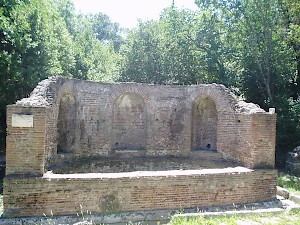
The end of the monarchy came in 231, and the Chaonians founded a republic, to which Buthrotum also belonged. It managed to remain neutral during the First and Second Macedonian War (214-205, 200-197), but was not so lucky in the Third Macedonian War (172-168). The Molossians sided with the Macedonian king Perseus, while the Chaones and Thesprotes supported Rome.note This was a good move, because Rome won the war. Maybe, the loot was used to pay for the new temple of the war goddess Athena.
The Roman Age
Technically, Buthrotum remained an independent ally, but a free city (civitas libera) was usually not very free and an allied city (civitas foederata) was often forced to send troops. Especially after the Senate had decided to convert Macedonia into a province (146), autonomy did not really matter; Buthrotum belonged to the province of Macedonia and simply had to obey its governor.
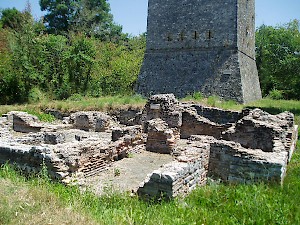
During the Second Civil War, in which Julius Caesar fought against the Senate and its general Pompey the Great, Buthrotum may have served as one of Caesar's supply bases, especially during the siege of Dyrrhachium (49/48) and the Pharsalus campaign (48); it was, in any case, elevated to the rank of colonia, which is a bit strange, because it was a small town that would not normally qualify for this honor. Caesar must have has a special reason to do so. However this may be, the port was certainly used by Titus Labienus, a senatorial commander, to transport German and Gallic cavalry to Africa.note A few years later, the town is again mentioned during a civil war, but again, it was of little importance.note.
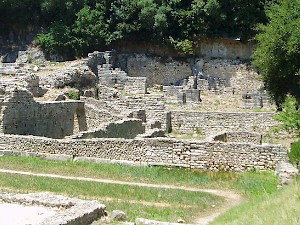
When the emperor Augustus (r.27 BCE - 14 CE) reorganized the Roman Empire, the road along the Dalmatian and Epirote shores was improved; it is shown on the Peutinger Map, which is based on the Map of Agrippa and dates back to this age. The map also shows Buthrotum: the port must have been a town of some importance - it was a colonia, after all. The town is also mentioned in a famous anecdote by Plutarch, who tells that during the reign of the emperor Tiberius (r.14-37), a sailor named Thamus was ordered by a supernatural voice to tell the people at Lake Palodes that the great god Pan had died.note
The second century witnessed Buthrotum's greatest prosperity. Archaeologists have established that at least three bathhouses were built, that an aqueduct was constructed across the lake, that the theater was renovated (the Romans preferred a different type of stage), that next to the theater, the Atrium House was built, that a nymphaeum (a decorated fountain) was constructed, and that a gymnasium was created on the site of an older market. In this gymnasium was another fountain house.
The Christian City
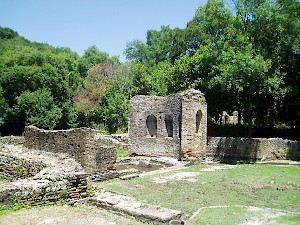
In the mid-third century, an age of crisis, the emperor Decius (r.249-251) ordered the execution of unrepenting Christians. One of these was a man named Terinus, who was thrown ad bestias in the theater of Buthrotum. The story, told by the tenth-century Byzantine bishop Arsenius of Corfu, is a bit problematic, because executions like these normally took place in amphitheaters. Perhaps our town had an, hitherto unidentified, building of this type; perhaps, Terinus was killed by a wild animal at the end of a play. If a Roman play ended with the violent death of the hero, the actor could be replaced by a convicted criminal, and this body double would die instead.
In the end, the Roman Empire overcame the third-century crisis and Christianity overcame its persecutors. Buthrotum must have become a Christian town too. However, the fourth century was not as splendid as the second. When the town suffered from an earthquake somewhere between 378 and 383, the damaged theater was no longer restored.
Still, the town could have done a lot worse. In the fifth century, the other towns of western Epirus declined more rapidly than Buthrotum, where the bishop rebuilt the city wall and constructed a palace that had no less than thirty-four rooms, surrounding a central courtyard. This would have been a large building by second-century standards too. Its inhabitant was a man of some reputation: in 516, bisschop Matthew of Buthrotum was part of an embassy to pope Hormisdas, for example.
A part of the explanation is that Buthrotum could easily be defended, easier than towns situated directly on the coast or on open land. The Dema Wall kept out the Slaves, who in 547-548 looted nearby Onchesmus (modern Saranda). Three years later, Buthrotum's position helped it ward off the Ostrogothic naval raiders. Because the town did not suffer, it is absent from Procopius' record of all repairs during the reign of the emperor Justinian (r.527-565), The Buildings. There was even money to build another church and an unusually large baptistery. Yet, although the decline was slower than elsewhere, it was a decline nevertheless.
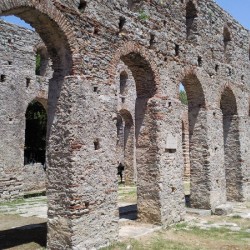 Buthrotum, Basilica |
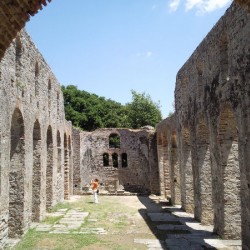 Buthrotum, Basilica |
 Buthrotum, Basilica |
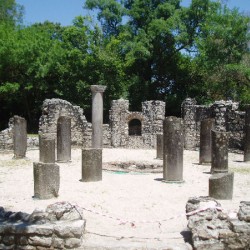 Buthrotum, Baptistery |
The town, shrunk to the acropolis and the part surrounding the bishop's palace, was usually controled by the Byzantine emperor in Constantinople, although it was once taken over by the Bulgarians and once by the Norman leader Bohemund of Taranto. When the Byzantine Empire diesintegrated, Buthrotum became a possession of the Venetians. They utilised the fisheries in Lake Palodes and used the acropolis to control the Strait of Corfu - much as it had once started.